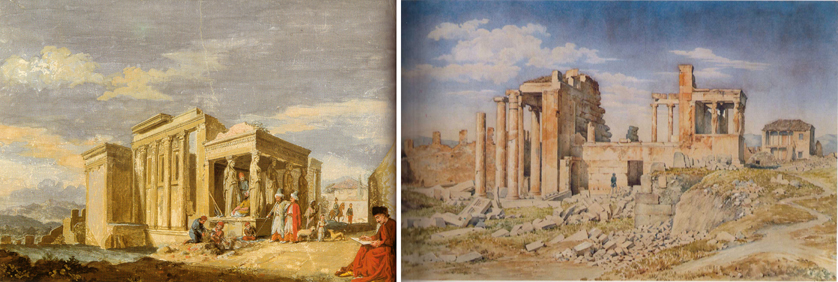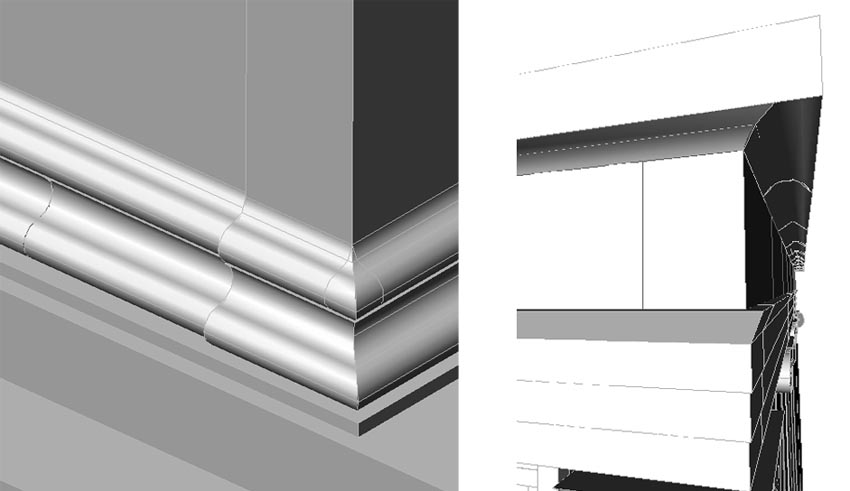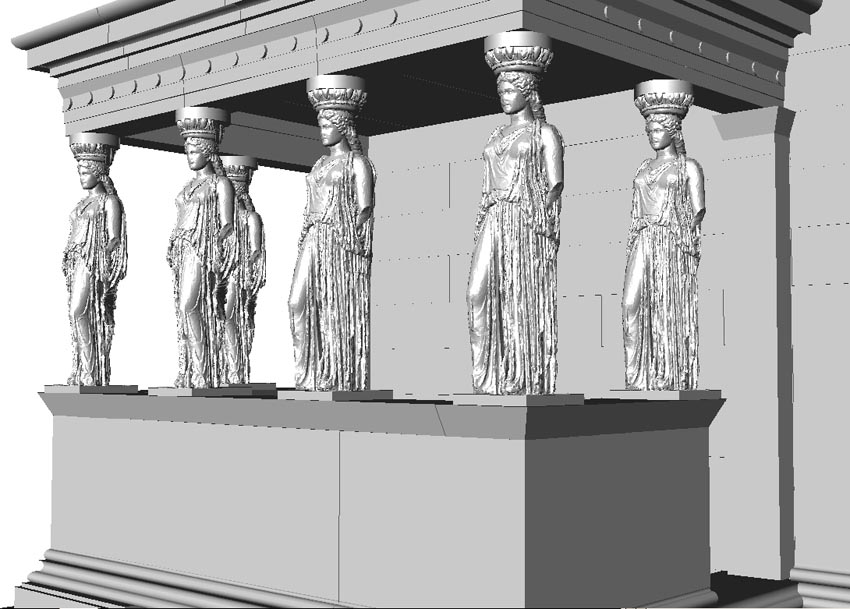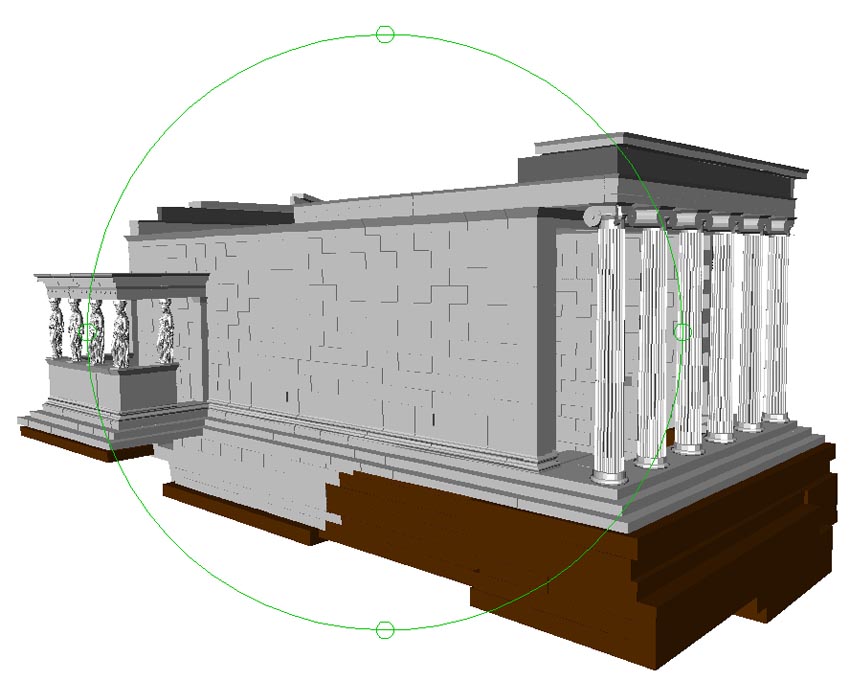
|
|
 |
Using AutoCAD to Construct a 4D Block-by-Block Model of the Erechtheion on the Akropolis at Athens, I: Modeling the Erechtheion in Four Dimensions
Paul Blomerus and Alexandra LeskIntroduction
This is the first article in a series for the CSA Newsletter describing a project to construct a 4D block-by-block CAD model of the Erechtheion on the Akropolis at Athens. This project forms part of a larger body of research conducted by Dr. Alexandra Lesk on the changes to the Erechtheion from the Classical period to the present (Lesk 2004). You can find a synopsis and fully-illustrated text of her Ph.D. thesis, A Diachronic Examination of the Erechtheion and its Reception, at www.erechtheion.org/erechtheion.htm.
This article sets out the CAD modeling strategy including layer-naming conventions and solid creation. The second article will be concerned with the details of connecting a spreadsheet-based database to the CAD model. The third and final article will discuss the visualization of results including interactive 3D worlds.
CAD Modeling Strategy
As part of her research, Dr Lesk had examined over one hundred 16th through 19th century paintings and drawings of the Erechtheion by early modern travelers to Greece. She hoped to discern accurately the changes to the building from its original construction through to the present day by noting the presence or absence of every block in each of these depictions.

She needed a means to collate and visualise the plethora of data emerging from this research. Using CAD was an obvious choice. However, unlike a conventional CAD model that depicts the building at a particular point in time, the model needed to show the changes to the building through time.
Fig. 2: Video showing changes to the Erechtheion between 1749 and 1933.
(If no video file plays, click here to download the file and play it on your computer with
Microsoft® Windows Media Player or an appropriate alternate.)
This approach required a novel application of CAD in archaeology. Previous archaeological and architectural historical CAD model developers have created digital renderings or even virtual environments reconstructing a site at a particular time in its history. Some good examples are listed on the CSA web site at csanet.org/inftech/cadgd/cadgdfour.html#ch4.1. Adding the dimension of time to our CAD model of the Erechtheion makes this a four- rather than a three-dimensional CAD model of an ancient building. Though other projects have created models of several phases of a single building, such as contained within the CAD model of the Older Propylon, a diachronic CAD model such as the one described here covering a period of some centuries in such detail has never been conceived of or attempted.
The point of departure was the creation of a 3D block-by-block model of the Erechtheion and its surroundings as it stands today. AutoCAD 2002 was used for the 3D modeling because it was familiar to the authors and lent itself readily to the task. We took guidance from the invaluable CSA CAD Guide for Archaeologists; therefore we shall not set out the basics of CAD modeling for archaeology here but rather highlight the main differences and novel features of our approach.
A +/- 5 mm accuracy in spatial position was chosen so that depictions would be readily recognisable but also withstand detailed scrutiny. The aim was to show the presence or absence of a block at a particular point in time, but not the individual blocks' actual decay or damage through time. This is in contrast to the CSA Propylaea Project which seeks, as one objective, to portray the actual state of the stone including millimetre accurate cracks and chips. Precise details of some of the sculptural elements such as column capitals were not attempted, but rather a recognisable and representative shape that is grossly dimensionally accurate.
The project aimed to depict the state of the building, that is the presence or absence of any given block, at any point in time. Building a separate model for every single change endured by the building was not a realistic option because of the sheer number of models that would have been required. Initially, using the AutoCAD Layer States Manager was considered: Grouping all blocks that fell off the building during a given time period in the same layer would allow them to be turned off or on as required. The problem is that some blocks have fallen off and been replaced several times over a 300 year period and so would need to belong to several layers. The only way to achieve this is to create multiple copies of the same block, one for each layer, which seemed inefficient.
A more flexible solution was needed. We decided to use a database that would be dynamically linked to the CAD model. The database would control the block states at every point in time. This way, the state of the building at a particular point in time could be depicted by "switching on" those blocks that were known to be present from the database. The CAD model would therefore only need to contain the geometric information with all other data contained in the database of block states.
The separation of temporal and interpretive information into a database that controls the AutoCAD model has additional benefits. The CAD model can focus on the information that it portrays best, which is the geometric and spatial information. Since dates of construction or functional usage are often interpretations of evidence, they fit better in a database where any inconsistencies can be explained and the sources cited. A database can even cope with multiple alternative interpretations. It leaves the CAD modeler free to concentrate on spatial and geometric matters, rather than constantly having to refer back to the archaeologists for a date or function when these may not yet be clearly established. Once these details have been established, they can be added, changed and updated without even opening the CAD model. (See "Divergent Views in CAD Models," by Harrison Eiteljorg, II, in this issue of the CSA Newsletter for comments about using AutoCAD layer names to deal with scholarly disagreements.)
The key to making this system work is to give each element in the model a unique reference number so that it can be cross-referenced and controlled by the database. In our case, each of the 1100+ blocks in the building had to have a unique reference number. Fortunately for us, the Akropolis Restoration Project had created a grid system for the Erechtheion that referenced each block by façade, course and block number. This grid system was quickly adopted and supplemented where necessary. The original grids are published in Platon et al. 1977, and the updated ones are published in Lesk 2004, figures 553-563.
Next we needed to label each block in the model with these unique reference numbers. We created an individual layer for each block and named it using the unique reference number. The AutoCAD layer name was chosen because it is an easily accessible and editable attribute in the AutoCAD interface, and also because the state and properties of a layer can be manipulated from outside AutoCAD using layer state (.las) files. We will go into the mechanics of how this can be achieved in the next article in this series.
Once the linkage between database and model is created, it is possible to illustrate any scenario on demand. For instance:
Depending on the level of detail contained in the database, this approach could be extended to change the state (i.e. presence or absence), colour or linetype of any entity in the model based on its function, year of excavation, elevation or any other property recorded in the database. Though some of this can be achieved with a careful layer-naming convention, the linked database approach has several major advantages when if comes to dealing with ambiguity. You can easily change your mind about an attribute in a database while recording the rationale for the change. You can also cope much more easily with multiple scenarios where, for example, scholars disagree about the date of construction of a particular architectural feature. As mentioned earlier, interpretive information can be entered into the model by non CAD-trained professionals.
Detailed CAD Model Creation
The excellent plans, elevations and detailed drawings by Gorham P. Stevens published in the 1927 volume, The Erechtheum (Paton et al., 1927) were the primary sources of the detailed geometric information required to set up the CAD model. An even more detailed survey of the building was conducted in the 1970s before the most recent restoration, the drawings from which were published in Platon et al., 1977. These drawings were consulted occasionally for detailed cross-checks. We also used our own first-hand observations, measurements and photographs of the building, taken by kind permission of the First Ephorate of Prehistoric and Classical Antiquities.
One AutoCAD drawing unit was chosen to equal 1 m. and the world coordinate system (AutoCAD's default coordinate system) aligned with the building axis for convenience. The modeling strategy suggested by the CSA guidelines of creating a master file containing only cross-references to major sub-models using the x-ref command was adopted. Figure 3 shows the master model with each sub-model changed to a different colour for clarity.

Fig. 3 - Sub-models of the Erechtheion.
To help with the creation of the sub-models so that they would fit together, a rectangle around the top most course of the building was created and copied into all sub-models. It was also helpful sometimes temporarily to cross-reference the adjoining sub-model from the model we were working on to make sure there were no gaps or overlaps.
With the advent of more powerful computers, the sub-modeling strategy may not have been strictly necessary for manipulation during model creation, but it is still a good final insurance policy against corrupt files. We would still recommend it, even if you have the fastest super PC or Mac out there.
Individual blocks were created as 3D solids by extruding polylines and then subtracting/adding other solid objects as required. The basic 4 x 2 x 1.5 Attic foot marble building blocks were all considered the same dimensions for the purposes of this study, even though in reality walls have been subtly tapered and inclined. Assembling the walls was therefore a relatively simple "copy and paste" exercise. Other parts of the building were less straightforward to construct and took careful study of drawings, photographs and autopsy to get right. Though obviously much less labour intensive than building the original, this "digital block-by-block" building method provided a deep insight into ancient construction methods. There was no major benefit to using the AutoCAD array command to create the plain expanses of the North and South façades at once because each block had to be labeled with its unique grid reference as it was laid.
Decorative sculptural elements were more difficult to achieve, but by following the detailed sections in Paton et al., 1927, with a polyline and then extruding it, a library of basic sculpted elements was quickly created.

Fig. 4 - Detail at the base of the wall and at frieze level.
The Ionic fluted column was created using the AutoCAD polyline extrusion with taper. The base was revolved and the capital assembled from extruded solids.

Fig. 5: Column base, flute and capital detail
The famous maidens of the South Porch were more of a challenge. Several solutions were considered including laser scanning a plaster model purchased in the Plaka market in Athens! Finally, we discovered that a team from the University of Southern California Institute for Creative Technologies had scanned a full-size plaster cast of Maiden number 3, the maiden currently housed in the British Museum. The plaster cast is on display in the Basel Skulpturhalle in Switzerland, and the Virtual Reality Modeling Language (VRML) file of the scan is available for access by all on the internet at gl.ict.usc.edu/parthenongallery. This file was easily transformed into a .dxf file for import into AutoCAD using AccuTrans 3D software by MicroMouse Productions. The same solid representation was mirrored to create the complementary set of sculptures, even though none of the original six maidens from the Erechtheion were ever truly identical. The original scan created by the USC team was too detailed to be manipulated with the computing power initially available for this research, so VSimplify, a freeware software authored by Virtue3D, was used to pare down the level of detail contained in the data to allow quick and easy manipulation of the model.

Fig. 6 - The Maidens of the South Porch
Typically, layer-naming conventions (including the CSA layer-naming convention) attempt to convey details about objects' date, material, function and position. We were unable take this exact approach because the layer name was being used for the unique reference number for each block in the model. We still wanted to enable the advanced search capability from within AutoCAD's layer state manager as described in the CSA guidelines to facilitate model editing.
The layer naming convention adopted was:
For example, the layer name "-NN01210" is used to designate the 10th block from the South end of the 12th course down in the North Façade.
AutoCAD has no problem with a large number of different layers in the model and at last count, the master model has 1161 layers.
The Results
The AutoCAD master model with all the x-ref sub-models displayed is easily manipulatable on a Windows XP PC with a 1.8 GHz AMD processor or similar Intel variety with 2GB of RAM. With a combination of the layer-state manager and view manager, you can quickly move to any position or state of drawing required. The 3D-orbit command still performs acceptably with shading and perspective "on" when the model is manipulated. Throughout the modeling process, which spanned several years, several computers with different operating systems, AutoCAD 2004 behaved admirably without a single corrupt file or unexplained error to deal with.

Fig. 7 - Using AutoCAD's "3D orbit" command to manipulate the model.
After the initial research to analyse the changes to the building between 1750 and the present day, we turned our attention to creating depictions of some of the earlier phases of the building. We have created a reconstruction of the building as it stood in Hellenistic times. A reconstruction for the Classical period was considered too difficult owing to the major damage suffered by the building not long after its initial construction. The bedrock and some of the nearby buildings on Akropolis were also modeled to give the building a physical context. We will show some of these visualisations in the final article in the series.
In the next article, we will explore in detail how we created the database linked to AutoCAD in order to manipulate the colours, line types and line weights in the model.
Conclusion
We have a presented a method by which one can add a fourth dimension to computer visualisations of ancient sites. This gives us a powerful tool capable of processing and presenting the results of a diachronic examination dynamically.
-- Paul Blomerus and Alexandra Lesk
Lesk, Alexandra L. A Diachronic Examination of the Erechtheion and Its Reception, Ph.D. Thesis, University of Cincinnati, 2004.
Paton, J. M., L. D. Caskey, H. N. Fowler, and G. P. Stevens. 1927. The Erechtheum, Cambridge, Mass.
Platon, N., S. Angelidis, J. Demakopoulos, G. Dontas, D. Lazarides, Ch. Bouras, Th. Skoulikidis, and I. Travlos. 1977. Μελέτη αποκαταστασέως του Ερεχθείου, Athens.
For other Newsletter articles concerning CAD or the use of electronic media in the humanities, consult the Subject index.
Next Article: Some Locally Adaptive Tone-Mapping Methods for Color and Exposure Error Correction
Table of Contents for the Fall, 2007 issue of the CSA Newsletter (Vol. XX, no. 2)
![]() Table of Contents for all CSA Newsletter issues on the Web
Table of Contents for all CSA Newsletter issues on the Web